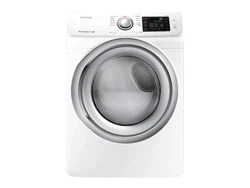Documents: Go to download!
- Owner's manual - (English, French, Spanish)
- Safety instructions
- Installing your dryer
- Operating instructions, tips
- Care and cleaning
- Special laundry tips
- Troubleshooting
Table of contents
USER GUIDE Samsung DV42H5200EW/A3 Dryer
Safety instructions
TO REDUCE THE RISK OF FIRE OR EXPLOSION:
- Do not dry items that have been previously cleaned, washed, soaked, or spotted with gasoline, dry cleaning solvents, or other flammable or explosive substances.
- They emit vapors that could ignite or explode. Any material that has been in contact with a cleaning solvent or flammable liquids or solids should not be placed in the dryer until all traces of these flammable liquids or solids and their fumes have been removed.
- There are many highly flammable items used in homes, such as acetone, denatured alcohol, gasoline, kerosene, some liquid household cleaners, some spot removers, turpentine, waxes, and wax removers.
- Do not dry items containing foam rubber (may be labeled latex foam) or similarly textured rubber-like materials on a heat setting. Heated foam rubber materials can, under certain circumstances, produce fire by spontaneous combustion.
WHAT TO DO IF YOU SMELL GAS:
- Do not try to light any appliance.
- Do not turn on the appliance.
- Do not touch any electrical switch.
- Do not use any phone in your building.
- Clear the room, building or area of all occupants.
- Immediately call your gas supplier from a neighbor’s phone. Follow the gas supplier’s instructions.
- If you cannot reach your gas supplier, call the fire department.
- Installation and service must be performed by a qualified installer, service agency, or the gas supplier.
Installing your dryer
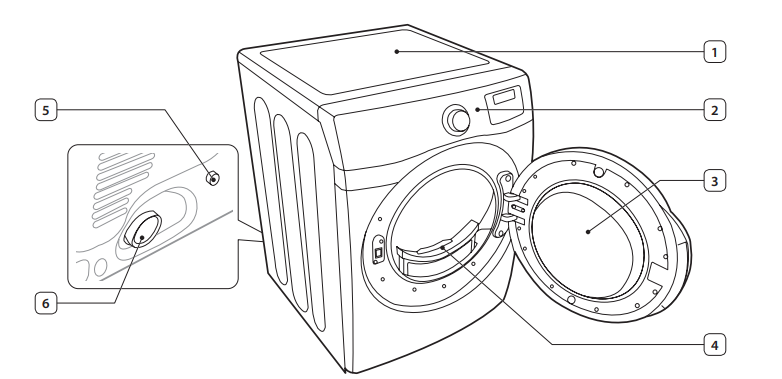
Basic requirements
- Make sure you have everything necessary for the proper installation
- A GROUNDED ELECTRICAL OUTLET is required.
- A POWER CORD electric dryer (except for Canada).
- GAS LINES (if a gas dryer) must meet national and local codes.
- The EXHAUST SYSTEM must be made of rigid metal or flexible stiff-walled metal exhaust ducting.
Grounding
- This dryer must be grounded. In the event of a malfunction or breakdown, grounding the product will reduce the risk of electrical shock by providing a path of least resistance for the electrical current.
Gas models
- Your dryer has a cord with an equipment-grounding conductor and a grounding plug.
- The plug must be plugged into an appropriate outlet that is properly installed and grounded in accordance with all local codes and ordinances.
- Do not modify the plug provided with your dryer – if it doesn’t fit the outlet, have a proper outlet installed by a qualified electrician.
- Never connect the ground wire to the plastic plumbing lines, gas lines, or hot water pipes.
Electric models
- Your dryer has an optional cord with an equipment-grounding conductor and a grounding plug, which is sold separately.
- The plug must be plugged into an appropriate outlet that is properly installed and grounded in accordance with all local codes and ordinances.
- Do not modify the plug provided with your dryer – if it doesn’t fit the outlet, have a proper outlet installed by a qualified electrician.
- If a power cord is not used and the electric dryer is to be permanently wired, the dryer must be connected to a permanently grounded metal wiring system, or an equipment grounding conductor must be run with the circuit conductors and connected to the equipment grounding terminal or lead on the dryer.
Alcove or closet installations
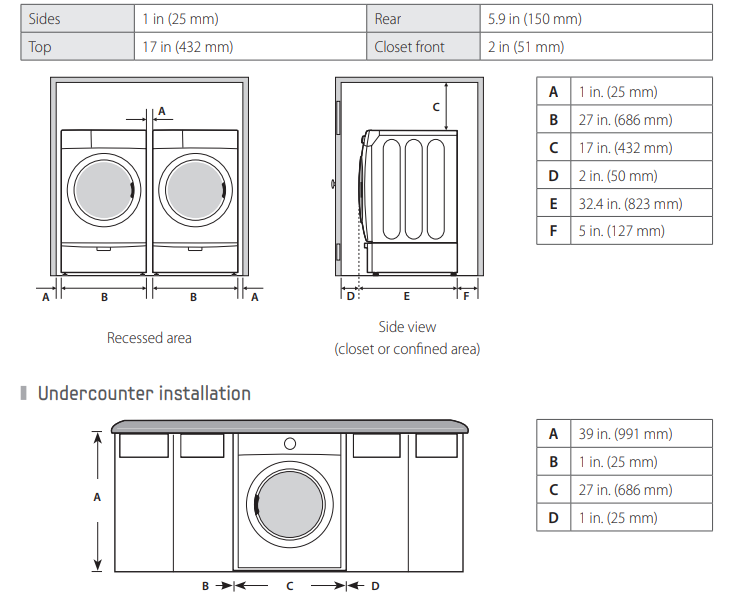
- If the new dryer is installed into an existing exhaust system you must make sure:
- The exhaust system meets all local, state, and national codes.
- That a flexible plastic duct is not used.
- To inspect and clean all lint buildup from inside the existing duct.
- The duct is not dented or crushed.
- The exhaust hood damper opens and closes freely.
- The static pressure in any exhaust system must not exceed 0.83 inches of water column, or be less than 0.
- This can be measured with the dryer running with a manometer at the point where the exhaust duct connects to the dryer. A no-heat setting should be used. The dryer tumbler should be empty and the lint filter clean.
Dryer exhaust tips
- Make sure your dryer is installed properly so it exhausts air easily.
- Use a 4” diameter rigid metal duct. Tape all joints, including at the dryer.
- Never use lint-trapping screws.
- Keep ducts as straight as possible.
- Clean all old ducts before installing your new dryer.
- Be sure the vent flap opens and closes freely.
- Inspect and clean the exhaust system annually.
Tape
- Don’t let a poor exhaust system slow the drying process by:
- Restricting your dryer with a poor exhaust system.
- Using a plastic, thin foil, or non-metal flexible duct.
- Unnecessarily using long ducts that have many elbows.
- Allowing dented or clogged ducts and vent
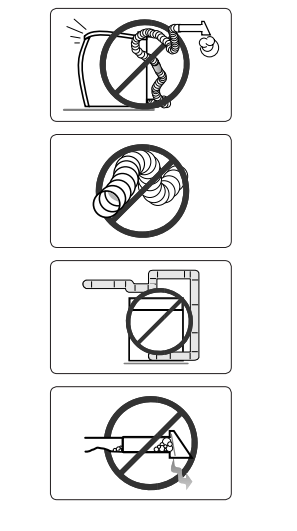
Connecting the inlet hose (Steam model only)
- The dryer must be connected to the cold water faucet using the new inlet hoses. Do not use old hoses.
- Turn the cold water faucet off.
- Attach the brass female end of the Y connector (A) to the cold water faucet.
- Attach the straight end of long hose (B) to the Y connector.
- Using pliers, tighten the coupling with an additional two-thirds turn.
- If the Y connector cannot be attached directly to the cold water faucet, the short hose must be used.
- If space permits, please skip steps 5 to 8, and go directly to step 9.)
Attach the short inlet hose (C) to the cold water faucet.
Screw on the coupling by hand until it is seated on the faucet.
- Using the pliers, tighten the coupling with an additional two-thirds turn.
- Attach the Y connector (A) to the brass male end of the small hose.
- Screw on the coupling by hand until it is seated on the connector.
- Using the pliers, tighten the coupling with an additional two-thirds turn.
- Attach the angled end of long hoses to the fill valve at the bottom of the dryer rear frame. Screw on the coupling by hand until it is seated on the fill valve connector.
- Using pliers, tighten the coupling with an additional two-thirds turn.
- Attach the washer hose (D) to the other side of the Y connector (A).
- Screw on the hose coupling until it is tight. Using pliers, tighten the coupling with an additional two thirds turn.
- Check that the water faucets are on.
- Check for leaks around the Y connector, faucets and hoses.
Replacement parts and accessories
- Move your dryer to an appropriate location for the installation.
- Consider installing the dryer and washer side-by-side, to allow access to the gas, electrical, and exhaust connections.
- Place two of the carton cushion-tops on the floor. Tip your dryer on its side so it lies across both cushion-tops.
Set your dryer back in an upright position.
- To ensure that the dryer provides the optimal drying performance, it must be level. To minimize vibrations, noise, and unwanted movement, the floor must be a perfectly level, solid surface.
- To set the dryer to the same height as the washer, fully retract the leveling feet (A) by turning them counterclockwise, then loosen the legs by turning them clockwise.
- Adjust the leveling feet only as much as necessary to level the dryer. Extending the leveling feet more than necessary can cause the dryer to vibrate.
- Review the “Exhausting” section on page 13 before installing the exhaust system.
- Install the ductwork from your dryer to the exhaust hood. The crimped end of the duct sections must point away from your dryer.
- DO NOT use sheet metal screws when assembling the ducting. These joints should be taped.
Never use plastic flexible exhaust material.
- Tip for tight installations: install a section of the exhaust system onto your dryer before putting it in place.
- Use duct tape to secure this section to your dryer, but do not cover the ventilation slots at the back of the unit in dryer cabinet.
Operating instructions, tips
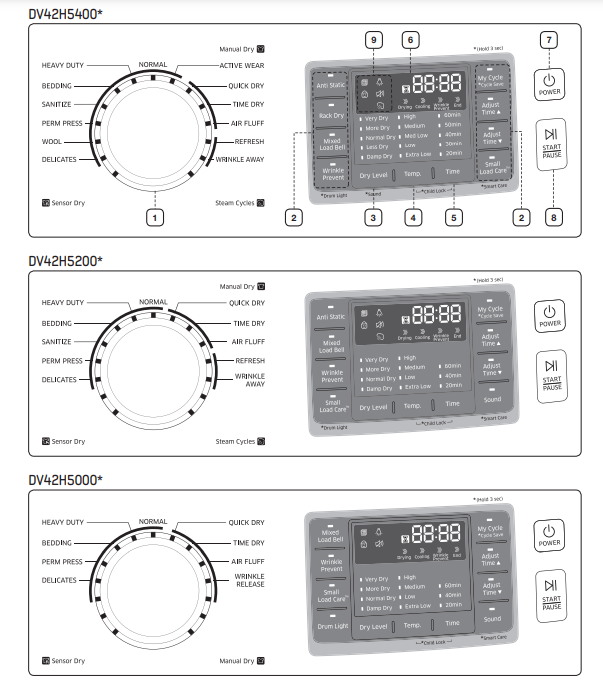
Dry Level
- To select the dry level in the NORMAL, HEAVY DUTY, or other Sensor Dry cycles, press the Dry Level button. An indicator light will illuminate next to the desired dryness level. Press the button repeatedly to scroll through the settings.
- Larger or bulkier loads may require the Very Dry or More Dry setting for complete drynes
- The Less Dry setting is best suited for lightweight fabrics or for leaving some moisture in the clothing at the end of the cycle. Damp Dry is designed to partially dry items. Use for items that lay flat or hang to dry
Temp.
- To select the correct temperature for the load, press the Temp. button. An indicator light will illuminate next to the desired temperature. Press the button repeatedly to scroll through the settings.

Time
- When using Manual Dry cycles, you can adjust the drying time by pressing the Time selection button.
- During the Sensor Dry cycle, the time light indicator is off because exact drying times are determined by fluctuating humidity levels.
LED Display
- The display window shows the estimated time remaining in the cycle after the Start/Pause button is pressed.
- The estimated time remaining may fluctuate as the cycle progresses.
- The Drying light will illuminate and remain lit until the cycle is complete.
- When your dryer is in the cool-down phase, the Cooling light will illuminate.
- When your dryer is in the wrinkle prevent phase, the Wrinkle Prevent light will illuminate.
- When the cycle is complete, “End” will appear in the display panel until the dryer door is opened or the Power button is pushed.
- If your dryer is paused during a cycle, the indicator lights will blink until the Start/Pause button is pressed.
Power
- Press once to turn your dryer on. Press again to turn it off. If your dryer is left on for more than 10 minutes without any buttons being touched, the power automatically turns off.
Load the dryer properly
- Place only one washload in your dryer at a time.
- Mixed loads of heavy and lightweight fabrics will dry differently, which may result in lightweight fabrics being dry while heavy fabrics remain damp at the end of a drying cycle.
- Add one or more similar items to your dryer when only one or two articles of clothing need drying.
- This improves the tumbling action and drying efficiency.
- Overloading restricts tumbling action, resulting in uneven drying as well as excessive wrinkling of some fabrics.
- If you insert laundry into your dryer while it is extremely tangled immediately after your washer has finished a wash or spin cycle, it may degrade the drying efficiency or cause the door to open. We recommend that you untangle your laundry appropriately before inserting it.
Getting started
- Load your dryer loosely (DO NOT overload).
- Close the door.
- Select the appropriate cycle and options for the load. (For detail, refer to the “Cycle overview” on next page.)
- Press the Start/Pause button.
- The dryer indicator light will illuminate.
- The estimated cycle time will appear in the display.
- The time may fluctuate as humidity levels fluctuate in the dryer.
- When the cycle is complete, “End” will appear in the display.
- Pressing Power cancels the cycle and stops your dryer.
- The Drying, Cooling, and Wrinkle Prevent indicator lights will illuminate during those portions of the cycle.
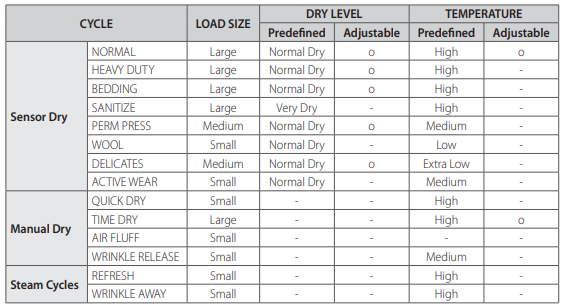
Installing the drying rack
1. Open the dryer door.
2. Position the drying rack in the tumbler, placing the front lip of the drying rack (A) on the top of the lint filter.
3. Place the rear legs in the two recessed areas of the dryer’s back wall, and then push down the middle of the drying rack to fix in place.
4. Place the items to be dried on the rack, leaving space between them so air can circulate.
5. Close the dryer door.
6. Press the Rack Dry button in the TIME DRY cycle and then select the time according to the amount of moisture and the weight of the items. The drying rack can be also used at AIR FLUFF cycle.
Smart Care
- This function enables you to check the status of the dryer using a smartphone.
- Press and hold tahe Small Load Care™ (DV42H5400*) or Sound (DV42H5200*, DV42H5000*) button for 3 seconds when an error occurs or if you haven’t pressed any buttons on the dryer after you turned the power on.
- When the Smart Care function is activated, the LED on the window display rotates for 2 or 3 seconds and then the error code will appear in the display panel.
- Run the Smart Care app on your smart phone.
- The Smart Care function has been optimized for: Galaxy & iPhone series (cannot be supported for some models).
- If the smart phone’s camera is focused on the display panel of the dryer, the panel and error message is automatically recognized and the error type and countermeasures are displayed on the smart phone.
- If the smartphone fails to recognize the error code more than twice, please enter the error code displayed on the display panel of the dryer manually into the Smart Care app.
Downloading the Smart Care app
- d the smartphone at too large an angle relative to the front of the display panel, it may not be able to recognize the error code. For best results, hold the smartphone so that the front of the panel and the smartphone are parallel or nearly parallel.
Care and cleaning
- Download the Samsung Laundry App into your mobile phone from the Android market or Apple App store.
- Search word : Samsung Smart Washer/Dryer)
- Precautions when using Smart Care
- If light from a light bulb, fluorescent bulb, or lamp is reflected on the display panel of the washing machine, the smartphone may not be able to recognize the panel or error message easily.
- If you hol
Control panel
- Clean with a soft, damp cloth. Do not use abrasive substances.
- Do not spray cleaners directly on the panel.
- The control panel finish may be damaged by some laundry pre-treatment soil and stain remover products.
- Apply such products away from your dryer and wipe up any spills or overspray immediately.
Tumbler
- Remove any stains caused by crayon, ink, or fabric dye (from new items such as towels or jeans) with an allpurpose cleaner.
- Tumble old towels or rags to remove any remaining stain or cleaning substance.
- Once these steps are followed, stains may still be visible, but should not transfer to subsequent loads.
- Stainless steel tumbler
- To clean the stainless steel tumbler, use a damp cloth with a mild, non-abrasive cleaner suitable for stainless steel surfaces.
- Remove the cleaner residue and dry with a clean cloth.
Dryer exterior
- Clean with a soft, damp cloth. Do not use abrasive substances.
- Protect the surface from sharp objects.
- Do not place any heavy or sharp objects or a detergent box on the dryer. Keep them on the purchased pedestal or in a separate storage box. This may scratch or damage the top cover of the dryer.
- Since the entire dryer has a high-gloss finish, the surface can be scratched or damaged.
- Avoid scratching or damaging the surface when using the dryer.
Dryer exhaust system
- Should be inspected and cleaned yearly to maintain optimum performance.
- The outside exhaust hood should be cleaned more frequently to ensure proper operation.
- Clean the lint filter
- After each load.
- To shorten drying time.
- To operate more energy efficiently.
- Do not operate your dryer without the lint filter in place.
Special laundry tips
Bedspreads & Comforters
- Follow the care label instructions or dry on the BEDDING cycle. Make sure the item is thoroughly dry before using or storing. May require repositioning to ensure even drying.
Blankets
- Use NORMAL cycle and dry only one blanket at a time for best tumbling action. Make sure the item is thoroughly dry before using or storing.
Curtains & Draperie
- Use the PERM PRESS cycle and Medium temperature to help minimize wrinkling. Dry these in small loads for best results and remove as soon as possible
Cloth Diaper
- Use the NORMAL cycle and the High temperature settings for soft, fluffy diapers.
- Down–filled Items (jackets, sleeping bags, comforters, etc.)
- Use the NORMAL cycle and the Medium temperature setting. Adding a couple of dry towels shortens drying time and absorbs moisture.
- Foam Rubber (rug backs, stuffed toys, shoulder pads, etc.)
- DO NOT dry on a heat setting. Use the AIR FLUFF cycle (no heat). WARNING – Drying a rubber item with heat may damage it or be a fire hazard.
Pillows
- Use the NORMAL cycle. Add a couple of dry towels and a pair of clean sneakers to help the tumbling action and to fluff the item. DO NOT dry kapok or foam pillows in dryer. Use the AIR FLUFF cycle.
Troubleshooting
Doesn’t run.
- Make sure the door is latched shut.
- Be sure the power cord is plugged into a live electrical outlet.
- Check the home’s circuit breaker and fuses.
- Press the Start/Pause button again if the door is opened during the cycle.
Doesn’t heat.
- Check the home’s circuit breaker and fuses.
- Select a heat setting other than Air Fluff.
- On a gas dryer, check that the gas supply is on.
- Clean the lint filter and exhaust duct.
- Dryer may have moved into the cool-down phase of the cycle.
Doesn’t dry.
- Check all of the above, plus...
- Be sure the exhaust hood outside the home can open and close freely.
- Check exhaust system for lint buildup. Ducting should be inspected and cleaned annually.
- Use a 4” rigid metal exhaust duct.
- Do not overload. 1 wash load = 1 dryer load.
- Sort heavy items from lightweight items.
- Large, bulky items like blankets or comforters may require repositioning to ensure even drying.
- Check that the dryer is draining properly to extract adequate water from the load.
- Load may be too small to tumble properly. Add a few towels.
Is noisy.
- Check the load for objects such as coins, loose buttons, nails, etc. Remove promptly.
- It is normal to hear the dryer gas valve or heating element cycle on and off during the drying cycle.
- Be sure the dryer is leveled properly as outlined in the installation instruction.
- It is normal for the dryer to hum due to the high velocity of air moving through the dryer drum and exhaust system.
Dries unevenly.
- Seams, pockets, and other similarly heavy areas may not be completely dry when the rest of the load has reached the selected dryness level. This is normal. Select the Very Dry setting if desired.
- If one heavy item is dried with a lightweight load, such as one towel with sheets, it is possible that the heavy item will not be completely dry when the rest of the load has reached the selected dryness level. Sort heavy items from lightweight items for best drying results.
Has an odor.
- Household odors from painting, varnishing, strong cleaners, etc. may enter the dryer with the surrounding room air.
- This is normal as the dryer draws the air from the room, heats it, pulls it through the tumbler, and exhausts it outside.
When these odors linger in the air, ventilate the room completely before using the dryer.
- Shuts off before load is dry
Dryer load is too small.
- Add more items or a few towels and restart the cycle.
Dryer load is too large.
- Remove some items and restart the dryer.
Lint on clothes
- Make sure the lint filter is cleaned before every load. With some loads that produce high amounts of lint, it may be necessary to clean the filter during the cycle.
- Some fabrics are lint producers (for example, a fuzzy white cotton towel) and they should be dried separately from clothes that are lint trappers (for example, a pair of lack linen pants)
Divide larger loads into smaller loads for drying.
- Check pockets thoroughly before washing and drying clothes.
- Garments still wrinkled after Wrinkle-Care
- Small loads of 1 to 4 items work best.
- Load fewer garments.Load similar-type garments.
- Odors remain in clothing after Refresh.
- Fabrics containing strong odors should be washed in a normal cycle.
Water drips from nozzle when SteamCare starts
- This is steam condensation. The dripping water will stop after a short time.
- Sprayed water is not visible during SteamCare
- Sprayed water is difficult to see when the door is closed.
Extended time
- Verify correct loading (clothes) / cycle selection (see page 26).
See other models: DV42H5200GW/A3 DV40J3000GW/A2 DV40J3000EW/A2 DV42H5000EW/A3 DV42H5000GW/A3
